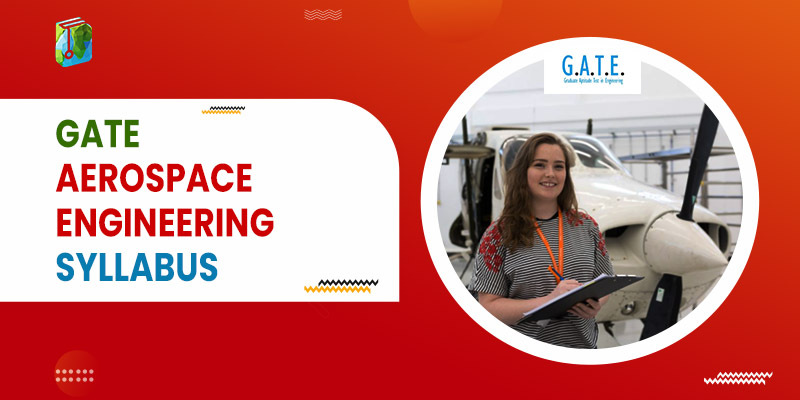Aerospace Engineering deals with the engineering of aircraft and other propulsion machinery. It is a very sought-after branch is engineering for candidates who want to make a career in aviation.
This article will give you complete information regarding the GATE Aerospace Engineering Syllabus 2024.
GATE Aerospace Engineering Syllabus
Aerospace Engineering consists of five sections Engineering Mathematics, Flight Mechanics, Aerodynamics, Structures, and Propulsion.
Engineering Mathematics
Linear Algebra, Calculus, Differential Equations
Flight Mechanics
Flight mechanics are relevant to fixed-wing (gliders, airplanes) and rotary wing (helicopters) aircraft. The syllabus is given below:
| Topics | Syllabus |
|---|---|
| Basics | Atmosphere: Properties, standard atmosphere. Classification of aircraft. Aeroplane (fixed-wing aircraft) configuration and various parts. |
| Aeroplane performance | Pressure altitude; equivalent, calibrated, indicated air speeds; Primary flight instruments: Altimeter, ASI, VSI, Turn-bank indicator. Drag polar; takeoff and landing; steady climb & descent, absolute and service ceiling; cruise, cruise climb, endurance or loiter; load factor, turning flight, V-n diagram; Winds: head, tail & crosswinds |
| Static stability | The angle of attack, sideslip; roll, pitch & yaw controls; longitudinal stick fixed & free stability, horizontal tail position and size; directional stability, vertical tail position and size; dihedral stability. Wing dihedral, sweep & position; hinge moments, stick forces. |
Books for GATE Flight Mechanics
| Books | Buy Now |
|---|---|
| Introduction to Flight | Click Here |
| Flight Mechanics Modeling and Analysis | Click Here |
| Mechanics of Flight | Click Here |
| Mechanics of Flight | Click Here |
Aerodynamics
Aerodynamics is the study of the motion of air, particularly its interaction with a solid object, such as an airplane wing. It is a sub-field of fluid dynamics and gas dynamics, and many aspects of aerodynamics theory are common to these fields. The syllabus is given below:
| Topics | Syllabus |
|---|---|
| Basic Fluid Mechanics | Conservation laws: Mass, momentum (Integral and differential form).
Potential flow theory: sources, sinks, doublets, line vortex, and their superposition; Viscosity, Reynold’s number. |
| Airfoils and wings | Airfoil nomenclature; Aerodynamic coefficients: lift, drag, and moment; Kutta-Joukoswki theorem; Thin airfoil theory, Kutta condition, starting vortex; Finite wing theory: Induced drag, Prandtl lifting line theory; Critical and drag divergence Mach number. |
| Compressible Flows | Basic concepts of compressibility, Conservation equations; One-dimensional compressible flows, Fanno flow, Rayleigh flow; Isentropic flows, normal and oblique shocks, Prandtl-Meyer flow; Flow through nozzles and diffusers. |
Books for GATE Aerodynamics
| Books | Click Here |
|---|---|
| Fundamentals of Aerodynamics | Click Here |
| Aerodynamics for Engineering Students | Click Here |
| Fundamentals of Aerodynamics | Click Here |
| Aerodynamics for Engineers | Click Here |
GATE Aerospace Engineering Syllabus – Structures
A structure is an arrangement and organization of interrelated elements in a material object or system, or the object or system so organized. Material structures include man-made objects such as buildings and machines and natural objects such as biological organisms, minerals, and chemicals. The syllabus is given below:
| Topics | Syllabus |
|---|---|
| Strength of Materials | States of stress and strain. Stress and strain transformation. Mohr’s Circle. Principal stresses. Three-dimensional Hooke’s law. Plane stress and strain; Failure theories: Maximum stress, Tresca and von Mises; Strain energy. Castigliano’s principles. Analysis of statically determinate and indeterminate trusses and beams. Elastic flexural buckling of columns. |
| Flight vehicle structures | Characteristics of aircraft structures and materials. Torsion, bending, and flexural shear of thin-walled sections. Loads on aircraft. |
| Structural Dynamics | Free and forced vibrations of undamped and damped SDOF systems. Free vibrations of undamped 2-DOF systems |
Books for GATE Structures
| Books | Buy Now |
|---|---|
| Theory of Structures | Click Here |
| Structural Analysis | Click Here |
| Matrix Methods of Structural Analysis | Click Here |
| Theory of Structures SMTS | Click Here |
Propulsion
Propulsion means to push forward or drive an object forward. The term is derived from two Latin words: pro, meaning before or forward; and pellere, meaning to drive. A propulsion system consists of a source of mechanical power, and a propulsor (means of converting this power into propulsive force). The syllabus is given below:
| Topics | Syllabus |
|---|---|
| Basics | Thermodynamics, boundary layers, and heat transfer and combustion thermochemistry. |
| Thermodynamics of aircraft engines | Thrust, efficiency, and engine performance of turbojet, turboprop, turboshaft, turbofan, and ramjet engines, thrust augmentation of turbojets, and turbofan engines. Aerothermodynamics of non-rotating propulsion components such as intakes, combustor, and nozzle. |
| Axial compressors: | Angular momentum, work, and compression, the characteristic performance of a single axial compressor stage, the efficiency of the compressor, and degree of reaction. |
| Axial turbines | Axial turbine stage efficiency |
| Centrifugal compressor | Centrifugal compressor stage dynamics, inducer, impeller, and diffuser |
| Rocket propulsion: | Thrust equation and specific impulse, vehicle acceleration, drag, gravity losses, multi-staging of rockets. Classification of chemical rockets, the performance of solid and liquid propellant rockets. |
Books for GATE Propulsion
| Books | Author/Publisher |
|---|---|
| Rocket Propulsion Elements | Click Here |
| Aircraft Propulsion | Click Here |
| Marine Propellers and Propulsion | Click Here |
| Submarine Propulsion: Muscle Power to Nuclear | Click Here |
Conclusion
The syllabus for the AE or Aerospace Engineering examination is vast. Therefore, proper planning and schedule are required. Devote more time to your weaker areas and practice more often.
Moreover, take as many mock tests as possible. It helps you to analyze your overall preparation.
Maintain a balance between hard work and smart work!
Good luck with your exams!
People are also reading:

